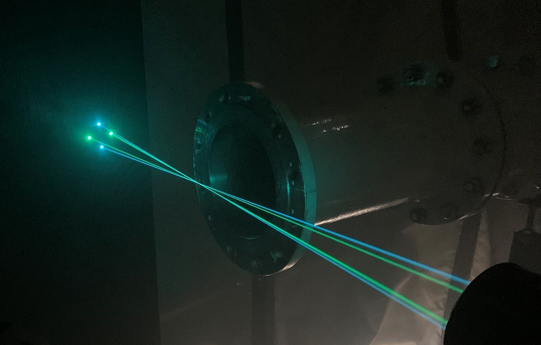Laser/Phase Doppler Anemometer
Application at the opened pipeline end of the closed loop air test rig
The laser/phase doppler anemometer (LDA/PDA) at the chair of fluidics is the FiberFlow system from Dantec. Currently, the system is used at the opened pipeline of the gas volume test rig for velocity measurements in pulsating flows.
Laser/Phase Doppler anemometry is a non-contact, optical measurement method that uses the Doppler effect to measure velocity in flows. For this purpose, particles are injected into the flow, at which the light emitted by the laser is reflected. From the Doppler shift of the scattered light, both velocity and size of the particles transported with the flow can be determined.
The key advantage compared to other measuring methods such as hot-wire or hot-film probes is the measurement without disturbing the flow. Furthermore, a high temporal and spatial resolution of the flow field is possible. The dual-beam LDA used at the chair of fluidics offers the possibility to measure velocity components in both main and cross flow direction simultaneously.
The basic unit of the FiberFlow system is the dual-beam laser transmitter. It consists of the laser including power supply, the beam splitting and frequency shifting optics as well as the fiber manipulators for coupling the laser beams into the light fibers. The beams are directed to the probe via the fiber optics. Here, the beam pairs are first expanded and then focused to shape the measurement volume (see Figure 1). The focal length depends on the used focusing lens. For the evaluation of the scattered light, a corresponding processor (Burst Spectrum Analyzer) including software (BSA Flow) is part of the system. Here, the velocity and particle size are determined from the Doppler shift. A software plug-in also offers the possibility for synchronization the LDA/PDA measurements with other measurement systems via trigger channels.
Under ideal conditions, it is possible to beam through the measurement area (compare Figure 1), so that the scattered light can be detected with the PDA receiving probe on the opposite side of the laser probe in forward scattering. For applications that do not allow beam through the measurement area, detection of the scattered light is also possible directly with the laser probe (backward scattering). Here, however, the determination of the particle size must be given up.
In addition to the FiberFlow system with PDA receiving probe, various focusing lenses are available at the chair of fluidics for focal length adaptation to the specific measurement task. A corresponding traverse system with three freely movable axes is used to mount and traverse the laser probe. This enables the spatial resolution of a measurement area of approx. 900 mm x 900 mm x 900 mm. The particles required for the measurement can be injected directly into the flow with the seeding generator, which is also present at the department. Alternatively, a fog generator is likewise available for flow visualization.


